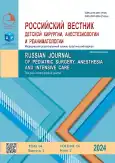IC型胆总管囊肿患儿诊断和治疗的特殊性
- 作者: Sinitsyn A.G.1,2, Perepelkin A.I.1,2, Kopan G.A.1,2
-
隶属关系:
- Volgograd State Medical University
- Clinical Emergency Hospital No. 7
- 期: 卷 14, 编号 2 (2024)
- 页面: 257-266
- 栏目: Case reports
- URL: https://journals.rcsi.science/2219-4061/article/view/263117
- DOI: https://doi.org/10.17816/psaic1796
- ID: 263117
如何引用文章
全文:
详细
胆总管囊肿或胆总管囊肿是肝外和/或肝内胆管的先天性囊性扩张。这种病症的诊断和治疗策略的选择往往会造成困难。回顾性分析了一例胆总管囊肿的临床病例,患者两岁,有复发性黄疸、胆管炎和胰腺炎症状,在准备根治术期间需要进行腹腔镜胆囊造口术和胆管造影术。患儿再次入住小儿外科,主诉体温高达39°C,周期性腹痛复发,恶心,巩膜和皮肤黄疸增加。实验室和超声波检查发现了胆道和胰腺高血压的迹象。诊断结果是:胆总管囊肿、胆汁淤积综合征、急性胆囊-胰腺炎。根据临床症状、实验室和超声波检查数据,紧急实施了腹腔镜胆囊造口术。在保守治疗的背景下,腹腔镜胆囊造口术后 2 天内,根据临床、实验室和对照超声检查的数据,胆道和胰腺高血压得到了临床、实验室控制。在没有额外麻醉的情况下,患儿通过胆囊造口术进行了胆管造影,结果显示肝总管和胆总管呈纺锤形扩张。在腹腔镜胆囊造口术的背景下,经过两周的药物治疗后,患儿接受了胆总管囊肿切除术和胆囊切除术,并在Roux环路上进行了肝肠吻合术。术后恢复顺利。在24个月的时间里,患者没有出现其他不适和并发症。根据我们的观察,复发性机械性黄疸是由胆总管囊肿引起的。 腹腔镜胆囊造口术能够快速、成功地控制胆道高压,为病人接受根治性手术治疗做好准备,并通过胆囊造口术安全地进行信息胆管造影。事实证明,肝肠吻合术已被证明是外科治疗胆总管囊肿的有效方法。
作者简介
Aleksey G. Sinitsyn
Volgograd State Medical University; Clinical Emergency Hospital No. 7
Email: all-sur04@mail.ru
ORCID iD: 0000-0002-8308-8364
SPIN 代码: 3223-7231
MD, Cand. Sci. (Medicine)
俄罗斯联邦, Volgograd; VolgogradAndrei I. Perepelkin
Volgograd State Medical University; Clinical Emergency Hospital No. 7
编辑信件的主要联系方式.
Email: similipol@mail.ru
ORCID iD: 0000-0001-5964-3033
SPIN 代码: 5545-8353
MD, Dr. Sci. (Medicine), Professor
俄罗斯联邦, Volgograd; VolgogradGleb A. Kopan
Volgograd State Medical University; Clinical Emergency Hospital No. 7
Email: gleb.kopan@yandex.ru
ORCID iD: 0000-0002-6627-1028
SPIN 代码: 1465-6360
MD, Cand. Sci. (Medicine)
俄罗斯联邦, Volgograd; Volgograd参考
- Razumovsky AYu, Rachkov VE. Surgery of biliary tracts in children. Manual for doctors. Moscow: GEOTAR-Media; 2020. 216 p. (In Russ.)
- Lee KH, Tam YH, Chan EKW, et al. A twenty-year experience in choledochal cysts in children: from open to laparoscopic excision. HK J Paediatr (New series). 2009;14(3):158–167.
- Morozov DА, Gusev АА, Pimenova ЕS. Bile duct cysts: modern aspects of surgical treatment and clinical observation of a rare case. Current Pediatrics. 2015;14(3):412–415. EDN: UBDZDR doi: 10.15690/vsp.v14i3.1380
- Borisova II, Kagan AV, Karavaeva SA, Kotin AN. Diagnostics and treatment of choledochal cysts in children. Russian Journal of Pediatric Surgery. 2020;24(3):161–166. EDN: TDUBRH doi: 10.18821/1560-9510-2020-24-3-161-166
- Razumovsky AYu. Paediatric surgery: national manual. Moscow: GEOTAR-Media; 2020. 1280 p. (In Russ.)
- Singham J, Yoshida EM, Scudamore CH. Choledochal cysts: Part 2 of 3: Diagnosis. Can J Surg. 2010;52(6):506–511.
- de Vries JS, de Vries S, Aronson DC, et al. Choledochal cysts: age of presentation, symptoms, and late complications related to Todani’s classification. J Pediatr Surg. 2002;37(11):1568–1573. doi: 10.1053/jpsu.2002.36186
- Soares KC, Arnaoutakis DJ, Kamel I, et al. Choledochal cysts: presentation, clinical differentiation, and management. J Am Coll Surg. 2014;219(6):1167–1180. doi: 10.1016/j.jamcollsurg.2014.04.023
- Edil BH, Cameron JL, Reddy S, et al. Choledochal cyst disease in children and adults: a 30-year single institutional experience. J Am Coll Surg. 2008;206(5):1000–1008. doi: 10.1016/j.jamcollsurg.2007.12.045
- Eiamkulbutr S, Tubjareon C, Sanpavat A, et al. Diseases of bile duct in children. World J Gastroenterol. 2024;30(9):1043–1072. doi: 10.3748/wjg.v30.i9.1043
- Razumovsky AYu, Degtyareva AV, Kulikova NV, et al. Laparoscopic surgery for biliary tract malformations in children. Russian Journal of Pediatric Surgery, Anesthesia and Intensive Care. 2012;2(1):19–24. EDN: OZPIMF
- Todani T, Watanabe Y, Toki A, Morotomi Y. Classification of congenital biliary cystic disease: special reference to type IС and IVA cysts with primary ductal structure. J Hepatobilairy Pancreat Surg. 2003;10(5):340–344. doi: 10.1007/s00534-002-0733-7
- Wang P, Gong Y, Lu S, Chen J. Three-dimensional visualization technique compared with magnetic resonance cholangiopancreatography for evaluation of anatomic variants of pediatric congenital choledochal cysts. Pediatr Surg Int. 2021;37(6):705–713. doi: 10.1007/s00383-020-04854-2
- Gezer HÖ. Pediatric choledochal cysts: Unknowns are decreasing. In: Shehata S, editor. Pediatric surgery, flowcharts and clinical algorithms. 2019. doi: 10.5772/intechopen.84301
- Sokolov YuYu, Valiulov IM, Yurkov SV, et al. First experience of laparoscopic resection of choledochal cysts and hepaticojejunoanastomosis in children. Endoscopic surgery. 2007;13(1):79–80. EDN: IAVZCX (In Russ.)
- Razumovskiy AYu, Rachkov VE, Shchapov NF. Low-invasive surgery in treatment of biliary atresia and cysts of the common bile duct. Clinical practice in pediatrics. 2011;6(5):32–39. EDN: OIGHEZ
- Lee H, Hirose S, Bratton B, Farmer D. Initial experience with complex laparoscopic biliary surgery in children: biliary atresia and choledochal cyst. J Pediatr Surg. 2004;39(6):804–807. doi: 10.1016/j.jpedsurg.2004.02.018
补充文件









